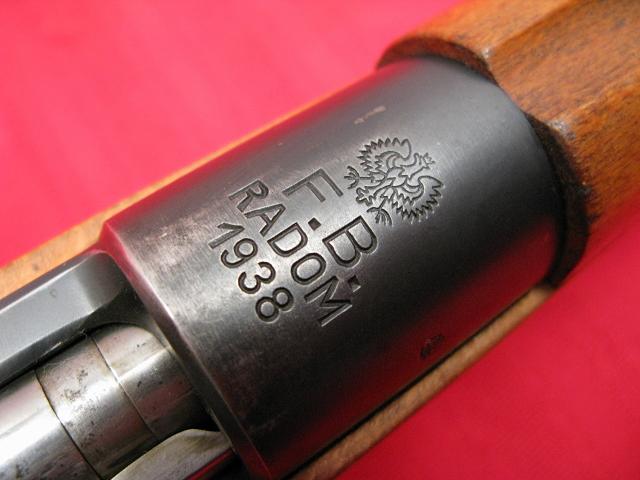Please Folks, no Pollock jokes in the comment section!
Poland has always been a hard luck country in may ways. What with being caught between Russia to the East and Germany to the West. Making it a kind of speed bump between the two.
 Yeah I know too soon!
Yeah I know too soon!

All right already, we get the picture! Move on!
So not being stupid. The Poles once they regained their independence after WWI. Quickly started up their own arms industry. Having looked around to see what was out there.
Wisely, they settled on the Mauser Bolt Action system. But as a relatively poor country. It could not match either Germany or Russia in military might. So you can guess the rest of the story.
 I actually doubt that the Poles charged Tanks with Lances.
I actually doubt that the Poles charged Tanks with Lances.
Moving right on. These are a very hard gun to find as they really got dragged thru WWII. As the Germans were more than happy to take these rifles into their army.
But if you can find one. They will make a great addition to anyone’s collection.
Here is some more information about these forgotten Guns!
The Polish Mauser from Wiki
The Karabinek wz.29 (Kbk wz.29; Polish: carbine model 29) was a Polish bolt-action short rifle based on the German Kar98AZ.
Identifying attributes include a 98/05 style mast bayonet lug ending directly beneath the front sight and winged protective ears to either side of the front sight blade.
Cavalry models featured a turned-down bolt handle, and early versions had a stacking hook near the end of the stock on the right side.
Design history
After regaining independence, the Polish Army was armed with weapons left over from the nations that occupied Poland during the Partition Era.
Including Russian M91 Mosin–Nagants, Austrian Steyr-Mannlichers, and German Gewehr 98s.
French Berthiers and Lebelsfrom the soldiers of the Blue Army were also on hand, as well as guns from Great Britain such as the Lee–Enfield and Japanese Arisaka.
As a result, at the end of Polish-Soviet War in 1921, the Polish army was armed with approximately 24 types of guns and 22 rifles firing different ammunition.
Since no armies ever have desired multiple types of firearms in multiple calibers for the same role due to the training, maintenance, and logistical nightmares involved.
The Polish Army sought to adopt a single type of rifle. Conveniently, the Treaty of Versailles, having established the Free City of Danzig, gave the Polish access to the tooling and machinery at the Danzig Arsenal.
Facilitating the choice of the Mauser 98 action as the basis for any new Polish military rifle. The Mauser was also arguably one of the best bolt-action rifles at the time and the best available to Poland.
Production of the wz.98 began in July 1922, after the Danzig machinery was moved to Warsaw to create the National Rifle Factory in Radom.
Two years later, production of the wz.98 rifles was stopped. The military sought to adopt an intermediate-length rifle.
Such as the Lee–Enfield, M1903 Springfield, and the German Karabiner 98a. Due to conclusions drawn from combat experience in World War I and the Polish-Soviet War.
It was based on the German Karabiner 98a. Polish K98a rifles differed from the German K98a only in minor technical details.
Field use of the K98a rifles showed that as an infantry weapon, and not a weapon for auxiliary or special troops as originally purposed, the design was inadequate.
The greatest flaw was the weak bayonet mount (the bayonet lug would break off when hitting hard objects). The K98a also used a small-ring Mauser action, which complicated production and parts interchangeability.
Following the postwar shift to large-ring carbines with 600 mm barrels and Gewehr 98-style bayonet lug/muzzle lengths, such as the Czech vz. 24, the decision was made to develop an intermediate model rifle for the Polish Army.
The design was finalized in 1929. The new wz.29 rifle was based on the old wz.98 rifle.
But with a shortened stock and barrel, stronger alloys for the receiver and barrel, a reinforced chamber, and increased dimensional tolerance in the action. This allowing for easy interchangeability of parts.
There were two versions of the rifle: Infantry models had straight bolt handles, while cavalry models had curved handles. Since both variations used the same stock, infantry models had a cutout in the stock for the curved handle.
Production of new weapons began in 1930 at the National Arms Factory in Radom. Despite wz. 98a long rifle production beginning in 1936, wz.29 production continued until September 1939, with a total of approximately 264,000 rifles produced, including rifles for export to Spain and Afghanistan.
During the September Campaign, wz.29 rifles were used by the Polish Army in the defense of Poland, against German troops using the similar Karabiner 98k.
After the defeat of Poland, they were used by the guerrillas of the Polish Underground. Captured wz.29 rifles were also used by the Wehrmacht as the Gewehr 298 (p).
Technical overview
Carbine wz.29 was a bolt-action rifle, with typical Mauser-action lock, with two large main lugs at the bolt head and a third safety lug at the rear of the it.
Ammunition was supplied from a fixed, two-row box magazine holding five rounds.
A three-position safety catch was attached at the rear of the bolt, securing the firing pin.
The sights consisted of an open post-type front sight, and a tangent-type rear sight with a V-shaped rear notch; the rear sight was a rear tangent sight was graduated 100 to 2000 meters at 100-meter intervals.
The weapon was equipped with a knife-type bayonet wz.29.
Operators
 Afghanistan – 100
Afghanistan – 100 Nazi Germany: some captured in 1939, rest produced under Occupation of Poland
Nazi Germany: some captured in 1939, rest produced under Occupation of Poland Palestine – 1.697
Palestine – 1.697 Republic of China – 12.450
Republic of China – 12.450 Saudi Arabia – 13.000
Saudi Arabia – 13.000 Second Polish Republic – around 250.000, standard-issue rifle
Second Polish Republic – around 250.000, standard-issue rifle Soviet Union: some captured in 1939
Soviet Union: some captured in 1939 Spanish Republic – 95.894, without Polish markings,
Spanish Republic – 95.894, without Polish markings, Spanish State: captured from Republicans
Spanish State: captured from Republicans
Around 10.561 were exported to unknown customer, probably Spanish Republic or Spanish State.
